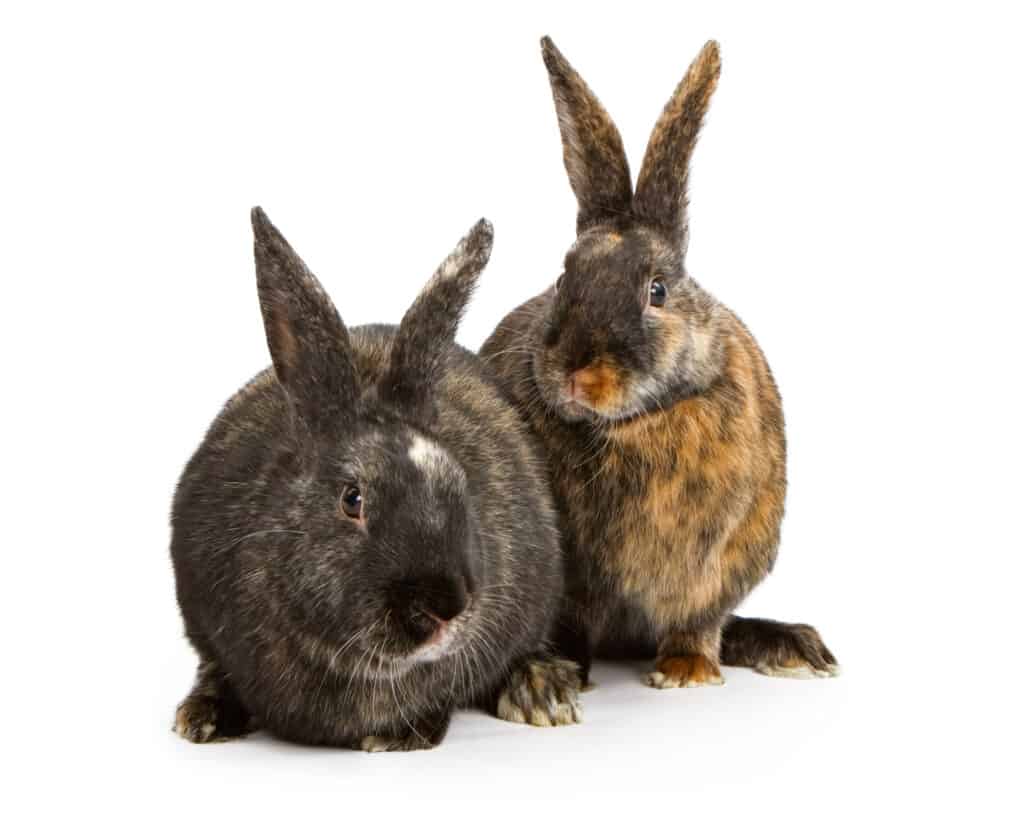Harlequin Rabbit
Oryctolagus cuniculus
Advertisement
Harlequin Rabbit Scientific Classification
- Kingdom
- Animalia
- Phylum
- Chordata
- Class
- Mammalia
- Order
- Lagomorpha
- Family
- Leporidae
- Genus
- Oryctolagus
- Scientific Name
- Oryctolagus cuniculus
Read our Complete Guide to Classification of Animals.
Harlequin Rabbit Conservation Status
Harlequin Rabbit Facts
- Name Of Young
- kittens
- Group Behavior
- Herd
- Biggest Threat
- rabbit diseases
- Gestation Period
- 31-33 days
- Litter Size
- 1-12
Harlequin Rabbit Physical Characteristics
- Color
- Blue
- Black
- White
- Orange
- Chocolate
- Lilac
- Multi-colored
- Skin Type
- Fur
- Top Speed
- 25 mph
- Weight
- 6-10#
- Age of Sexual Maturity
- 4-4.5 months
- Age of Weaning
- 4-6 weeks
- Venomous
- No
- Aggression
- Low
View all of the Harlequin Rabbit images!
Summary
A colorful breed based on its coloration and markings, the Harlequin Rabbit originates from France. It comes in two traditional color patterns and typically looks either black and orange or black and white. A well-muscled, medium-sized breed, Harlequin Rabbits make excellent family pets. Although they used to be quite popular, they are now considered a relatively rare breed.
5 Harlequin Rabbits Facts
- One of the oldest domestic rabbit breeds, the Harlequin Rabbit first appeared in Paris in 1887.
- The Harlequin Rabbit comes in two varieties – Japanese and Magpie – which refer to its distinctive coat colors.
- People used to call Harlequin Rabbits Japanese rabbits, but the name changed during the Second World War, although the term Japanese is still used to refer to one of the breed’s color varieties.
- Given its two-toned appearance, the Harlequin Rabbit is also referred to as the “clown of rabbits,” because its coat resembles the clothes worn by court jesters in the Middle Ages.
- Although the average lifespan of a Harlequin Rabbit is around 5 years, it can easily live to be 10 to 12 years old.
Harlequin Rabbit Scientific name
The Harlequin Rabbit’s scientific name is Oryctolagus cuniculus. This name is used to refer to the European rabbit and all of its 305 descendants that make up the known breeds of domestic rabbits. Oryctolagus stems from the Ancient Greek words oryktos or “dug up” and lagos, which means “hare.” The word cuniculus is more complex, as it is a Latin word that technically means “burrow” but can also apply to rabbits. This scientific name is used for all domestic rabbits because they share a common ancestor, the European rabbit.
Harlequin Rabbit Appearance
Harlequin Rabbits are one of the most unusual-looking rabbit breeds. Traditionally speaking, they come in two color varieties, Japanese and Magpie. Japanese Harlequins usually appear half orange and either black, blue, chocolate, or lilac. Meanwhile, Magpie Harlequins look partly white and either black, blue, chocolate, or lilac. For show rabbits, the brighter the orange or white in the coat, the better. The fur on Harlequin rabbits is typically rather short but is also quite soft and dense. As such, they require very little grooming.
According to breeding guidelines, Harlequin rabbits should be evenly split between their two colors on the head, ears, feet, and body. Ideally, the face will be evenly split between the two colors, similar to the two-toned masks worn by court jesters in the Middle Ages. Additionally, the ears should alternate colors with the face, and the back feet should alternate with the front feet. That said, these marking guides technically only apply to show rabbits. In real life, Harlequins come in all sorts of assorted patterns.
Compared to other domestic rabbits, Harlequins can be classified as a medium-to-large breed. Most Harlequins will weigh between 6.5 and 9.5 pounds, with females typically weighing slightly heavier than males. They have round-shaped heads and medium-length ears that tend to stand upright.

Harlequins, like most rabbits, are sociable and enjoy the company of other rabbits and humans.
©GoodFocused/Shutterstock.com
Harlequin Rabbit Behavior
Like most other domestic rabbits, Harlequins are quite docile and good-natured. They enjoy playing and spending time with their owners, being carried or petted. By nature, rabbits are gregarious, sociable creatures and Harlequin Rabbits are no exception. They can get quite lonely if left on their own and they enjoy spending time with other rabbits. A group of rabbits is known as a herd, so you may want to consider getting a herd of your own if you intend to raise happy Harlequin Rabbits.
Harlequin Rabbits are quite trusting and therefore easy to train. With proper time and training, they can learn to come when called and can also be potty trained. They have an inquisitive nature and will spend a lot of time exploring their surroundings. This means that they also feature a tendency to escape, so you’ll want to watch your Harlequin Rabbits closely to ensure they don’t get into too much trouble.
Harlequin Rabbit Habitat
Harlequin Rabbits first appeared in France in 1887. They spread to England shortly thereafter and arrived in the United States around the 1920s. Harlequin Rabbits do not live in a specific habitat since people usually keep them as pets. You can usually find them in gardens, houses, or yards, or in rabbit hutches or cages. Formerly domestic populations that have escaped or been released can be found in meadows, woods, forests, or grasslands. Like other rabbits, they live in underground dens known as burrows. That said, you’re unlikely to find many wild Harlequin Rabbits, as most domestic rabbits lack the instincts needed to survive in the wild.
Harlequin Rabbit Diet
Like other rabbits, Harlequin Rabbits are herbivores that eat a diet composed mostly of hay grasses. Generally speaking, Harlequin Rabbits should receive a fresh bundle of hay each day that is roughly the same size as their body. They can eat a limited amount of fresh vegetables such as dark leafy greens, along with an even smaller amount of fresh fruit. You may also supplement a Harlequin Rabbit’s diet with a small amount of pellet food. Nutritional and food requirements will vary depending on a Harlequin’s size, age, and activity level.
Harlequin Rabbit Predators and Threats
Given that Harlequin Rabbits live almost exclusively as pets, they lack natural predators. That said, you should still take precautions to keep your Harlequin Rabbit safe, especially if you let it play outside or keep other pets in the house. The major threats to domestic Harlequin Rabbits come from other pets such as cats and dogs, which can seriously hurt or kill rabbits. Additionally, diseases such as head tilt, Myxomatosis, rabbit viral hemorrhagic disease, and uterine tumors all commonly affect Harlequin Rabbits and can seriously affect their quality of life.
In the wild, rabbits face a number of threats including predators, inclement weather, and human activity including hunting and collisions with vehicles. Nearly all carnivorous predators are capable of killing rabbits. This includes cats, dogs, foxes, wolves, weasels, ferrets, stoats, martens, minks, birds of prey, and snakes. Most predators sneak up on rabbits, particularly when they are outside of their burrows foraging for food. To survive, rabbits evolved a keen sense of smell and hearing as well as powerful, long legs to help them escape predators.
Harlequin Rabbit Reproduction and Life Cycle
Most Harlequin Rabbits reach sexual maturity at around 4 to 4.5 months old. When does are receptive to mating, they may act restless and more outgoing toward other rabbits. They may also lie down and present themselves by lifting their tails. Does can act very territorial, and may become aggressive around other females when in heat. As such, does should always be taken to a buck’s cage when breeding. Mating normally occurs very quickly, during which the buck will mount and hold onto the doe’s neck with his teeth.
Gestation usually lasts between 31 and 33 days with an average litter size of between five or 6 baby rabbits, also known as kittens. That said, litter sizes can range anywhere from 1 to 12 kittens. Like other rabbits, Harlequins are very prolific, and a single female can easily give birth to 60 babies in a year. During the first 2 weeks of life, babies will live exclusively off of their mother’s milk. Once they reach around 2 weeks old they will start to eat grasses, pellets, and water. While they are generally weaned around 4 to 6 weeks old, they may continue to drink milk until 8 or 9 weeks.
The average lifespan for a Harlequin Rabbit is around 5 years old. That said, they can easily live up to 10 or 12 years given the proper care and certain genetic factors. Harlequin Rabbits must deal with several common ailments including abscesses, poisoning, digestive issues, loss of balance or head tilt, paralysis, loss of appetite, respiratory issues, and certain rabbit-specific viruses.
Harlequin Rabbit Population
People bred the first Harlequin Rabbits from semi-wild Tortoiseshell Dutch rabbits. Although they enjoyed several decades of popularity among breeders, they have since become somewhat rare. As no data exists on Harlequin Rabbit population trends, it’s hard to say how many exist around the world. That said, despite their decrease in popularity, the population appears to be holding steady. The breed remains popular as a show rabbit and there are several dedicated breeding groups still raising Harlequin Rabbits throughout the world.
Harlequin Rabbit Locations
While they originated in France, today Harlequin Rabbits are found all over the world wherever domestic rabbits are kept. That said, you’re most likely to find them in the US or Europe, thanks to the presence of dedicated Harlequin Rabbit clubs. Although it’s hard to know for certain, you can probably find Harlequin Rabbits in homes in all 50 US states.
Harlequin Rabbit Conservation Status
Since Harlequin Rabbits are a domestic breed, they are listed as Not Evaluated by the IUCN. However, the wild ancestor of the Harlequin Rabbit, the European rabbit, is currently listed as Endangered due to dwindling populations in its native Iberia. The Harlequin Rabbit used to be quite a popular breed, but it is now somewhat rare and most often bred as a show rabbit. That said, the Harlequin Rabbit still has a dedicated following, so it’s unlikely that Harlequin Rabbits will disappear anytime soon.
View all 104 animals that start with HHarlequin Rabbit FAQs (Frequently Asked Questions)
Are Harlequin Rabbits carnivores, herbivores, or omnivores?
Like all rabbits, Harlequin Rabbits are herbivores. A typical Harlequin Rabbit eats a diet of mostly grass hay, some fresh vegetables, and a small amount of pellet food.
Are Harlequin Rabbits expensive?
Although they used to be quite popular, Harlequin Rabbits are now a relatively rare breed. On average, Harlequin Rabbits cost between $20 and $100, with show quality rabbits usually fetching a higher price.
Are Harlequin Rabbits friendly?
Today, people primarily breed Harlequin Rabbits for shows and competitions due to their striking coats. That said, some people choose to keep them as companion pets. They are quite docile and friendly, making them an excellent choice for small children.
How much space does a Harlequin Rabbit need?
A Harlequin Rabbit requires enough space for it to grow, sleep, and play. When it isn’t hopping around your home or garden, you’ll want to keep your Harlequin Rabbit in a cage around 3 feet long and 2 feet wide. That said, the larger the cage, the better, as Harlequin Rabbits are quite a large breed and will take advantage of all the space they can get.
Thank you for reading! Have some feedback for us? Contact the AZ Animals editorial team.

















